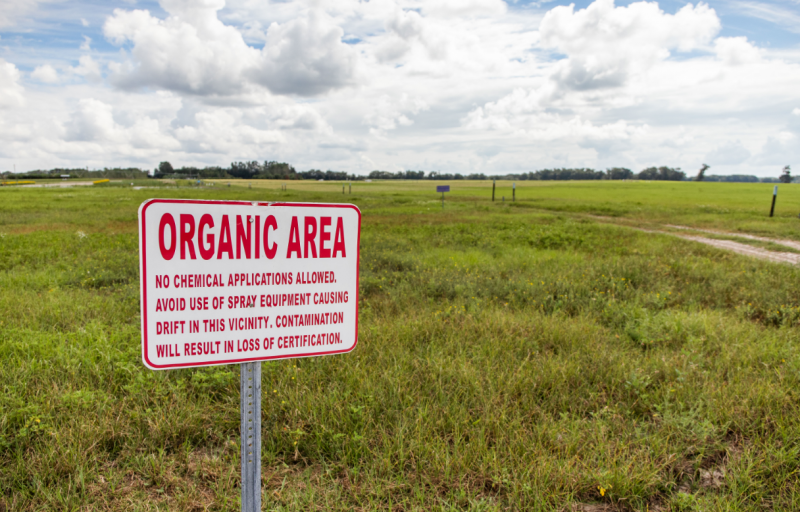There are many farming systems utilized world-wide, with conventional agriculture being the most prevalent. However, alternative systems, like organic and all-natural farming, are becoming more popular than ever before.
–
Organic Farming
With any farming system, there are positive and negative attributes. This is the case for both organic and all natural production systems. Organic farming promotes environmental health through the adoption of best management practices (BMPs). Yields may be comparable, but are typically less than conventional ag production. Reduced yields can be offset by increased marketing opportunities, as organically produced products generally sell for a premium, as compared to their conventionally produced counterparts. The major hurdles of this type of farming system are the establishment of a regional market for the commodity, and of course, becoming certified organic. For the farmer to become “organic” by the USDA guidelines, a strict protocol must be followed. This entails a 3-yr period of following guidelines before certification & use of the label. So, what are these guidelines? For starters, using only naturally-occurring, living or previously-living inputs as fertilizers and implementing best management practices such as utilizing integrated pest management (IPM) plans, crop rotation, on-site composting and cover crops.
–
The All-Natural Approach
What if you are not interested in making the investment or long-term commitment to be “certified organic“? Instead, implementing one or more of the all-natural practices may be a viable option for your operation. All-natural farming practices promote long-term environmental health and potential cost cutting measures through BMPs, not unlike organic farming. However, strict regulation or certifications are limited or nonexistent, therefore the crop is not held to the same standard, but may also lack the marketing appeal of certified organic farming. This system allows the farmer to find his/her own balance of production practices and consumer willingness to pay some level of price premium.
–
IPM Practices
Integrated Pest Management (IPM) is a four-step approach, encompassing cultural, mechanical, biological and chemical management measures that can be used to prevent and combat pest issues. Take for example a scenario where a citrus operation is producing a lower yield due to an issue with insect population. Cultural methods could be implemented to insure a more pest free environment. Are the trees healthy overall? Are the trees fertilized and irrigated at optimum? Healthy trees with vigor can often combat pest issues. Mechanical methods include any measure where insects are disposed of by hand or device. Biological control methods can include the release of insect species that can control the threat. An example of this would be the introduced parasitoid wasp, T. radiata, which can be dispersed to control the Asian citrus psyllid (D. citri), the vector for the devastating citrus disease known as citrus greening or HLB. Lastly, there are chemical options to consider, if needed. IPM guidelines recommend environmentally softer options be applied first as control options, before harsher chemicals are utilized.
With either the organic or all-natural ag practices, the IPM strategies are more limited to only non-synthetic or naturally produced products. Certified organic farms have approved IPM products with “organic” specified on the product label. Whereas, all-natural systems may utilize many of these same products, but may choose IPM options that are not labeled for organic production. The challenge is to match consumer demands, and market appropriately. For example, consumers may opt for all natural beef, meaning only natural products are used for the animals, but may not be concerned about synthetic fertilizer use in the pastures. Whichever system you choose, conventional, natural, or organic, the key is to find a market niche to meet consumer demands and garner as high a price as possible. Organic production has the advantage of USDA guidelines and name recognition, the all-natural systems require either direct sales, or a network of producers and processors to develop products that offer premiums for the products produced.
For more information, contact your local county extension office.
–
More information on this topic can be found in the references for this article:
UF/IFAS EDIS publication, “Introduction to Organic Crop Production” by Danielle Treadwell and Jose Perez
Wu J., Sardo V. (2010) Sustainable Versus Organic Agriculture. In: Lichtfouse E. (eds) Sociology, Organic Farming, Climate Change and Soil Science. Sustainable Agriculture Reviews, Vol 3. Springer, Dordrecht.
- Managing Pine Stands for Straw Production - January 10, 2025
- Disaster Preparedness for the Ranch - June 21, 2024
- Winter Storm Damage to Your Honeybee Operation? Federal Disaster Assistance Program Could Help - January 12, 2024

